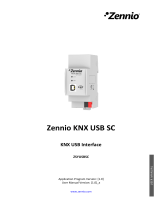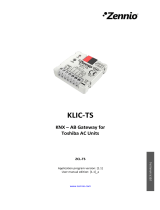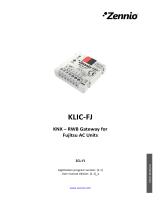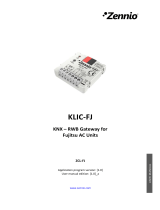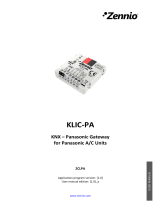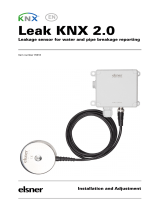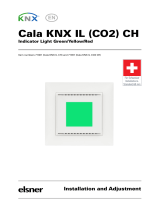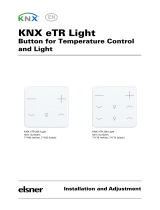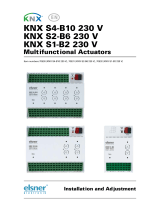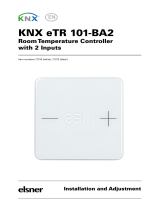Page is loading ...

KLIC-MITTE
http://www.zennio.com Technical Support: http://support.zennio.com
2
CONTENTS
Contents ................................................................................................................................... 2
Document Updates ................................................................................................................... 3
1 Introduction ...................................................................................................................... 4
KLIC-MITTE ................................................................................................................... 4
Installation ................................................................................................................... 5
Start-Up and Power Loss .............................................................................................. 6
2 Configuration .................................................................................................................... 7
General ........................................................................................................................ 7
ECODAN Gateway......................................................................................................... 9
2.2.1 Configuration ....................................................................................................... 9
2.2.2 Initial Configuration ............................................................................................ 13
2.2.3 Error Handling .................................................................................................... 16
Inputs ......................................................................................................................... 17
2.3.1 Binary Input ........................................................................................................ 17
2.3.2 Temperature Probe ............................................................................................ 17
2.3.3 Motion Detector ................................................................................................. 17
Logic Functions ........................................................................................................... 18
ANNEX I. Communication Objects ........................................................................................... 19

KLIC-MITTE
http://www.zennio.com Technical Support: http://support.zennio.com
4
1 INTRODUCTION
KLIC-MITTE
KLIC-MITTE from Zennio is a new gateway that provides full-duplex communication
between the KNX home automation system and Mitsubishi Electric Ecodan air-
conditioning and hot water management systems through the IT Terminal interface.
Because of this bidirectional communication, the air conditioning system can be
controlled from the home automation system in the same manner as it is through its
own controls. Moreover, the actual status of the unit can be monitored and periodically
sent to the KNX bus to inform other devices.
The most outstanding features of KLIC-MITTE are:
Bidirectional control of Ecodan ME (Mitsubishi Electric) units through their IT
Terminal connector (CN105).
Control of the main functions of the Ecodan unit: On/Off, temperature, mode
of operation, etc.
Error management to handle specific error codes from the unit itself as well
as any communication issues that may arise.
Two analogue-digital inputs, for the connection of temperature probes,
motion detectors or binary pushbuttons or switches.
10 customisable, multi-operation logic functions.
Heartbeat or periodic “still-alive” notification.

KLIC-MITTE
http://www.zennio.com Technical Support: http://support.zennio.com
5
INSTALLATION
Figure 1. Element scheme
KLIC-MITTE connects to the KNX bus via the corresponding built-in terminal (5). Once
the device is provided with power from the KNX bus, both the physical address and the
KLIC-MITTE application program can be downloaded.
This device does not need any external power as it is entirely powered through the
KNX bus.
The remaining elements are described next.
Prog./Test button (2): a short press on this button will set the device into the
programming mode, making the associated LED (1) light in red.
Note: if this button is held while plugging the device into the KNX bus, the
device will enter into safe mode. The LED will blink in red every 0.5 seconds
Analogue-Digital Inputs (3): input ports for the stripped cables of external
elements such as switches, motion detectors, temperature probes, etc.
Communication cable (4): cable with a CN105 connector that will connect
KLIC-MITTE to the unit. The other end of the cable, therefore, is intended to
be connected to the IT Terminal connector in the PCB board of the internal
unit.
1. Prog./Test LED indicator
2. Prog./Test button
3. Analogue/digital inputs
4. IT Terminal connection cable.
5. KNX connector

KLIC-MITTE
http://www.zennio.com Technical Support: http://support.zennio.com
6
Figure 2. Connecting KLIC-MITTE to the Ecodan unit
Important: KLIC-MITTE is designed for FTC5 control systems. For other control
systems, that many functions are disabled must be taken into account. In addition,
certain parameterisations made in the device can be ignored.
Note: For a correct parameterization and behaviour of the KLIC-MITTE, it must be
considered that the units of the FTC5 control systems have internal switches that allow
to enable and disable certain characteristics of it. Consult the Mitsubishi unit manual for
more information.
For detailed information about the technical features of KLIC-MITTE, as well as on
security and installation procedures, please refer to the device Datasheet, bundled in
the device packaging and also available at http://www.zennio.com.
START-UP AND POWER LOSS
Depending on the configuration, some specific actions will be performed during the
device start-up. The integrator may set up an initial status to be sent to the unit after
the bus power recovery, and whether certain objects should be sent to the bus after the
power recovery, as described in later sections.
On the other hand, when a bus power failure takes place, the device will interrupt any
pending actions, and will save its state so it can be recovered once the power supply is
restored.
C I
1 2 C
1 2 C
1 2 C
14
11
□
39
DDv3
MITTv2
Común
Común

KLIC-MITTE
http://www.zennio.com Technical Support: http://support.zennio.com
7
2 CONFIGURATION
GENERAL
After importing the corresponding database in ETS and adding the device into the
topology of the desired project, the configuration process begins by entering the
Parameters tab of the device.
ETS PARAMETERISATION
The “General” screen is shown in the first place, containing the following parameters:
Figure 3. General
Ecodan Gateway [enabled]
1
: entails all functions specific to KLIC-MITTE,
relating to communication with the Ecodan unit and management of the
climate and hot water control system. For more information, see section 2.2.
Inputs [disabled/enabled]: enables or disables the “Inputs” tab in the tree on
the left. For more information, see section 2.3.
Logic Functions [disabled/enabled]: enables or disables the “Logic
Functions” tab in the tree on the left. For more information, see section 2.4.
Heartbeat (Periodic Alive Notification) [disabled/enabled]: this parameter
lets the integrator incorporate a one-bit object to the project (“[Heartbeat]
Object to Send ‘1’”) that will be sent periodically with value “1” to notify that
the device is still working (still alive).
1
The default values of each parameter will be highlighted in blue in this document, as follows:
[default/rest of options].

KLIC-MITTE
http://www.zennio.com Technical Support: http://support.zennio.com
8
Figure 4. Heartbeat
Note: the first sending after download or bus failure takes place with a delay
of up to 255 seconds, to prevent bus overload. The following sendings match
the period set.
Regardless of the above parameters, the following objects are available by default:
“[General] On/Off” and “[General] On/Off (Status)”: allow switching on
(value “1”) and off (value “0”) the Ecodan unit or reading the current status,
respectively.
Several error objects. See section 2.2.33.
“[Climate] Operation (Status)” and “[Climate] Allowed/Prohibited
(Status)”: allow reading the current state of the climate.
“[Climate] [Zone 1] Temperature Setpoint” and “[Climate] [Zone 1]
Temperature Setpoint (Status)”: allow setting the desired temperature
setpoint or reading the current value, respectively. See section 2.2.1 for
further information.
“[Climate] [Zone 1] Temperature Control Mode (Status)”: allows reading
the type of control that the unit performs (Flow/Room/Compensation Curve)
respectively. See section 2.2.1 for further information.

KLIC-MITTE
http://www.zennio.com Technical Support: http://support.zennio.com
9
ECODAN GATEWAY
2.2.1 CONFIGURATION
KLIC-MITTE allows controlling and monitoring an Ecodan unit.
Through the KNX bus, commands to control the following basic functions can be sent
to KLIC-MITTE:
On/Off switch of the Ecodan unit.
Climate control and supervision:
Climate operation and permission status: allows to know if the unit is
working and if it is authorised.
Climate mode: depending on unit characteristics, climate mode can be
changed between heating or cooling. Also, its status can be read.
Machine climate setpoint temperature of the available zones. The
temperature can be modified within a range of values according to the
selected temperature control mode.
1 or 2 climate zones can be controlled.
Climate temperature control mode: using KLIC-MITTE, temperature
control mode can be known (flow temperature, room temperature,
compensation curve), but it only can be changed by wired remote control.
Flow temperature: this mode allows setting a fluid setpoint for heating
or cooling mode whose ranges will be:
o Heating: [25…60] ºC
o Cooling: [5…25] ºC
Room Temperature: allows to establish a temperature setpoint for
heating mode.
o Heating: [10…30] ºC

KLIC-MITTE
http://www.zennio.com Technical Support: http://support.zennio.com
10
Compensation Curve: is intended to be modified by the wired remote
control, therefore, the sending of setpoints from KLIC-MITTE in this
mode is meaningless.
Note: When control by Compensation Curve is established only in
Heating Mode, it should be taken into account that, in that case, the
temperature control is performed entirely by the machine, so any
temperature setpoint sent to the KLIC will be ignored and the flow
temperature setpoint calculated by the machine using the
compensation curve will return by the status object. Thus, as explained
above, what is shown on the control and on the status object of the
KLIC is:
o Wired remote control: shows the increase or decrease in
temperature that the user wishes to perform on the flow
temperature setpoint calculated by the machine.
o KLIC-MITTE: flow temperature resulting from applying the
internal compensation curve of the machine plus the increase
desired by the user from the wired remote control.
Domestic Home Water (DHW) control and supervision: its operation is
based on the activation of a heat pump that heats the water to the desired
temperature.
Setpoint temperature: temperature at which the water in the DHW tank
will be heated.
DHW operating and permission status: allows to discern when the unit
is heating water and when it is not and if it is authorised.
On the other hand, KLIC-MITTE allows the configuration of the following advanced
functions:
Advanced Modes: allows to enable objects to activate the general Holiday
Mode, and the Economy and Forced Modes in the DHW system.
Initial Configuration: allows to define the desired initial value for the unit
states after the device has been programmed or restarted.

KLIC-MITTE
http://www.zennio.com Technical Support: http://support.zennio.com
11
In addition, KLIC-MITTE provides an error management function (see section 2.2.33),
which allows sending messages to the KNX bus in case the A/C unit reports any errors.
ETS PARAMETRIZATION
The “Configuration” tab under Ecodan Gateway provides the following parameters:
Figure 5. Ecodan Gateway Configuration
UNIT TYPE
Climate Mode Available [Heating / Cooling/Heating]. If “Cooling/Heating” are
selected, the following 1-Bit object will be enabled: “[Climate] Operation
Mode” and “[Climate] Operation Mode (Status)”. These will allow to
choose under which mode (cold or heat) the unit will operate and to monitor
its status.
Number of Available Zones [1 / 2]: indicates the number of zones supported
by the unit. Depending on which one it is, the objects corresponding to the
second zone will be displayed. In a generic way, the objects shown by zone
will be:
“[Climate] [Zone X] Temperature Setpoint”: allows to set the desired
setpoint according to the mode in which the temperature control is
performed.

KLIC-MITTE
http://www.zennio.com Technical Support: http://support.zennio.com
12
“[Climate] [Zone X] Temperature Setpoint (Status)”: allows to know the
setpoint temperature at which the machine is working.
“[Climate] [Zone X] Temperature Control Mode (Status)”: 1-Byte
object that allows to know the temperature control mode status. The
available modes are listed in
Table 1. Temperature Control Modes.
Domestic Hot Water (DHW) [enabled/disabled]: allows to show or hide the
initial configuration objects and parameters linked to the ACS management
(see section 2.2.2). The objects are as follows:
“[DHW] Operation (Status)”: 1-bit object that allows to know if the
domestic home water management system is idled or operative.
“[DHW] Allowed/Prohibited (Status)”: 1-bit object to know if DHW
system is allowed to be controlled.
“[DHW] Temperature Setpoint” and “[DHW] Temperature Setpoint
(Status)”: allows to set and monitor the temperature setpoint for the water
in the tank. Range: [40…60] ºC.
ADVANCED MODES
Advanced Modes [enabled/disabled]: allows to show or hide the following
objects, as well as the configuration of the corresponding initial states, if the
initial configuration has been selected as custom (see section 2.2.2).
“[General] Holiday Mode” y “[General] Holiday Mode (Status)”: 1-bit
objects to control and monitor the activation of the Holiday Mode.
Object Value
Control Mode
0
Flow Temperature
1
Room Temperature
2
Compensation Curve

KLIC-MITTE
http://www.zennio.com Technical Support: http://support.zennio.com
13
Furthermore, domestic hot water management system has two independent
modes of operation. The 1-bit objects used to control and supervise them are
as follows:
“[DHW] Economy Mode” and “[DHW] Economy Mode (Status)”. The
value "1" will cause economy mode activation, whereas value “0” will
activate normal mode. Current status of this mode can be known with
“[DHW] Economy Mode (Status)” object.
“[DHW] Forced Mode” and “[DHW] Forced Mode (Status)”. Sending
the value "1" through "[ACS] Forced Mode" will cause the hot water to
activate, even if the ACS is in "Prohibited" mode.
COOLING/HEATING MODE AFTER ETS DONWLOAD
Zone 1 / Zone 2
Heating/Cooling after ETS Download [Flow Temperature / Room
Temperature / Compensation Curve]: allows to indicate the temperature
control mode after download for heating mode. For Cooling Mode, due to
intrinsic unit restrictions, only “Flow Temperature” is available.
Note: If zone 1 is set to “Room Temperature”, this option will not be available
in zone 2. The unit does not allow two zones operating in this mode.
INITIAL CONFIGURATION
Initial Configuration [Default / Custom]: enables or disables the “Initial
Configuration” in the left menu. For more information, see section 2.2.2.
2.2.2 INITIAL CONFIGURATION
The custom initial configuration allows setting the desired status that KLIC-MITTE will
send the unit after downloading or restarting the device. This status is defined in terms
of On/Off, domestic home water and climate.
In addition, it is possible to activate an initial sending of this status to the KNX bus.

KLIC-MITTE
http://www.zennio.com Technical Support: http://support.zennio.com
14
ETS PARAMETRISATION
After selecting “Custom” for the Initial Configuration option under the “Configuration”
tab (see section 2.2.1), a new tab named Initial Configuration is displayed with the
following parameters:
Figure 6. Ecodan Gateway. Initial configuration.
GENERAL
On/Off [Last / On / Off].
When Domestic Hot Water (DHW) is enabled in “Configuration” tab (see section
2.2.1), the following parameters will be shown:
DOMESTIC HOT WATER
Forced Mode [Last / On / Off]. It requires the general state of the machine to
be On in order to be available.
Economy Mode [Last / On / Off].

KLIC-MITTE
http://www.zennio.com Technical Support: http://support.zennio.com
15
Note: Initial configuration of the ACS modes will only available if advanced modes
are enabled in “Configuration” tab (see section 2.2.1).
Setpoint [disabled/enabled]:
Value:
Last: only available if Setpoint parameter remains disabled.
40…60 ºC: concrete value of the set temperature.
CLIMATE
Operating Mode [Last / Cooling / Heating].
Zone 1 / Zone 2
Setpoint [disabled/enabled]:
Value:
Last: only available if Setpoint parameter remains disabled.
5…25…60 ºC: concrete value of the set temperature. The available
range varies depending on the selected operating mode.
Initial Sending of Status [disabled/enabled] if this option is enabled, the
corresponding status objects will be sent to the KNX bus with the indicated
delay [0…3600] [s].
Note: even if the option to send the initial configuration is not enabled, the
status sending could also take place if the initial stated configured is different
from the one currently available on the machine.
Note: If “Last” is selected in any of the previous parameters, the same value will be
maintained as it was before its restart.

KLIC-MITTE
http://www.zennio.com Technical Support: http://support.zennio.com
16
2.2.3 ERROR HANDLING
KLIC-MITTE is capable of managing two error types that do not entail any previous
parameter configuration:
Communication o internal error: error in the communication process between
KLIC-MITTE and the Ecodan unit.
In case KLIC-MITTE is unable to connect to the machine, it stops responding or
returns wrong traces, the device will send the 1-Bit object “[General] Internal
Error: Communication” with a value of “1. If this happens, the green LED will
remain on. Once the error is over, it the object will be sent with a value of “0”.
Error in the unit: errors reported by the unit itself. KLIC-MITTE can notify the
KNX bus about the reported error code, although referring to the specific
documentation of the machine is advisable in order to obtain further information.
In case the unit reports an error, the binary object “[General] Unit Error:
Active Error” will be sent with value “1”, while the 14-bytes object
“[General] Unit Error: Error Code” will report the corresponding error code.
Once the error is over, the binary object will send a value of “0” and error code
object will update its value to “0”. Please, refer to Mitsubishi error codes
documentation for details about the error codes.

KLIC-MITTE
http://www.zennio.com Technical Support: http://support.zennio.com
17
INPUTS
KLIC-MITTE incorporates two analogue/digital inputs, each configurable as a:
Binary Input, for the connection of a pushbutton or a switch/sensor.
Temperature Probe, for the connection of a temperature sensor.
Motion Detector, for the connection of a motion detector from Zennio.
2.3.1 BINARY INPUT
Please refer to the “Binary Inputs” user manual, available in the KLIC-MITTE product
section, at the Zennio website (www.zennio.com).
2.3.2 TEMPERATURE PROBE
Please refer to the “Temperature Probe” user manual, available in the KLIC-MITTE
product section, at the Zennio website (www.zennio.com).
2.3.3 MOTION DETECTOR
It is possible to connect motion detectors from Zennio to the input ports of KLIC-MITTE.
Please refer to the “Motion Detector” user manual, available in the KLIC-MITTE
product section, at the Zennio website (www.zennio.com) for detailed information about
the functionality and the configuration of the related parameters.

KLIC-MITTE
http://www.zennio.com Technical Support: http://support.zennio.com
18
LOGIC FUNCTIONS
This module makes it possible to perform numeric and binary operations with incoming
values received from the KNX bus, and to send the results through other
communication objects specifically enabled for this purpose.
KLIC-MITTE can implement up to 10 different and independent functions, each of
them entirely customisable and consisting in up to 4 consecutive operations each.
The execution of each function can depend on a configurable condition, which will be
evaluated every time the function is triggered through specific, parameterisable
communication objects. The result after executing the operations of the function can
also be evaluated according to certain conditions and afterwards sent (or not) to the
KNX bus, which can be done every time the function is executed, periodically or only
when the result differs from the last one.
Please refer to the “Logic Functions” user manual (available in the KLIC-MITTE
product section at the Zennio homepage, www.zennio.com) for detailed information
about the functionality and the configuration of the related parameters.

KLIC-MITTE
http://www.zennio.com Technical Support: http://support.zennio.com
19
ANNEX I. COMMUNICATION OBJECTS
“Functional range” shows the values that, with independence of any other values permitted by the bus according to the object size, may be of any use or have a
particular meaning because of the specifications or restrictions from both the KNX standard or the application program itself.
Number
Size
I/O
Flags
Data type (DPT)
Functional Range
Name
Function
1
1 Bit
I
C - - W -
DPT_Switch
0/1
[General] On/Off
0 = Off; 1 = On
2
1 Bit
O
C T R - -
DPT_Switch
0/1
[General] On/Off (Status)
0 = Off; 1 = On
3
1 Bit
I
C - - W -
DPT_Switch
0/1
[General] Holiday Mode
0 = Off; 1 = On
4
1 Bit
O
C T R - -
DPT_Switch
0/1
[General] Holiday Mode (Status)
0 = Off; 1 = On
5
1 Bit
O
C T R - -
DPT_Alarm
0/1
[General] Unit Error: Active Error
Unit Error
6
14 Bytes
O
C T R - -
DPT_String_ASCII
[General] Unit Error: Error Code
See Unit Manual
7
1 Bit
O
C T R - -
DPT_Alarm
0/1
[General] Internal Error: Communication
Unable to Set Communication
8
1 Bit
O
C T R - -
DPT_Switch
0/1
[Climate] Operation (Status)
0 = Idle; 1 = Operative
9
1 Bit
O
C T R - -
DPT_Enable
0/1
[Climate] Allowed/Prohibited (Status)
0 = Prohibited; 1 = Allowed
10
1 Bit
I
C - - W -
DPT_Heat_Cool
0/1
[Climate] Operation Mode
0 = Cooling; 1 = Heating
11
1 Bit
O
C T R - -
DPT_Heat_Cool
0/1
[Climate] Operation Mode (Status)
0 = Cooling; 1 = Heating
12, 15
2 Bytes
I
C - - W -
DPT_Value_Temp
-273.00° - 670760.00°
[Climate][Zone x] Temperature Setpoint
[5...60] ºC
13, 16
2 Bytes
O
C T R - -
DPT_Value_Temp
-273.00° - 670760.00°
[Climate][Zone x] Temperature Setpoint
(Status)
[5...60] ºC
14, 17
1 Byte
O
C T R - -
DPT_Temp_Ctrl_Mode
[Climate][Zone x] Temperature Control
Mode (Status)
0 = Flow Temperature; 1 = Room
Temperature; 2 = Compensation Curve
18
1 Bit
O
C T R - -
DPT_Switch
0/1
[DHW] Operation (Status)
0 = Idle; 1 = Operative
19
1 Bit
O
C T R - -
DPT_Enable
0/1
[DHW] Allowed/Prohibited (Status)
0 = Prohibited; 1 = Allowed
20
2 Bytes
I
C - - W -
DPT_Value_Temp
-273.00° - 670760.00°
[DHW] Temperature Setpoint
[40...60] ºC
21
2 Bytes
O
C T R - -
DPT_Value_Temp
-273.00° - 670760.00°
[DHW] Temperature Setpoint (Status)
[40...60] ºC
22
1 Bit
I
C - - W -
DPT_Switch
0/1
[DHW] Economy Mode
0 = Off; 1 = On
23
1 Bit
O
C T R - -
DPT_Switch
0/1
[DHW] Economy Mode (Status)
0 = Off; 1 = On
24
1 Bit
I
C - - W -
DPT_Switch
0/1
[DHW] Forced Mode
0 = Off; 1 = On
25
1 Bit
O
C T R - -
DPT_Switch
0/1
[DHW] Forced Mode (Status)
0 = Off; 1 = On
26, 30
2 Bytes
O
C T R - -
DPT_Value_Temp
-273.00° - 670760.00°
[Ix] Current Temperature
Temperature Sensor Value
27, 31
1 Bit
O
C T R - -
DPT_Alarm
0/1
[Ix] Overcooling
0 = No Alarm; 1 = Alarm
28, 32
1 Bit
O
C T R - -
DPT_Alarm
0/1
[Ix] Overheating
0 = No Alarm; 1 = Alarm
29, 33
1 Bit
O
C T R - -
DPT_Alarm
0/1
[Ix] Probe Error
0 = No Alarm; 1 = Alarm

KLIC-MITTE
http://www.zennio.com Technical Support: http://support.zennio.com
20
34, 40
1 Bit
I
C - - W -
DPT_Enable
0/1
[Ix] Input Lock
0 = Unlock; 1 = Lock
35, 41
1 Bit
C T - - -
DPT_Switch
0/1
[Ix] [Short Press] 0
Sending of 0
1 Bit
C T - - -
DPT_Switch
0/1
[Ix] [Short Press] 1
Sending of 1
1 Bit
I
C T - W -
DPT_Switch
0/1
[Ix] [Short Press] 0/1 Switching
Switching 0/1
1 Bit
C T - - -
DPT_UpDown
0/1
[Ix] [Short Press] Move Up Shutter
Sending of 0 (Up)
1 Bit
C T - - -
DPT_UpDown
0/1
[Ix] [Short Press] Move Down Shutter
Sending of 1 (Down)
1 Bit
C T - - -
DPT_UpDown
0/1
[Ix] [Short Press] Move Up/Down Shutter
Switching 0/1 (Up/Down)
1 Bit
C T - - -
DPT_Step
0/1
[Ix] [Short Press] Stop/Step Up Shutter
Sending of 0 (Stop/Step Up)
1 Bit
C T - - -
DPT_Step
0/1
[Ix] [Short Press] Stop/Step Down
Shutter
Sending of 1 (Stop/Step Down)
1 Bit
C T - - -
DPT_Step
0/1
[Ix] [Short Press] Stop/Step Shutter
(Switched)
Switching of 0/1 (Stop/Step Up/Down)
4 Bit
C T - - -
DPT_Control_Dimming
0x0 (Stop)
0x1 (Dec. by 100%)
...
0x7 (Dec. by 1%)
0x8 (Stop)
0xD (Inc. by 100%)
...
0xF (Inc. by 1%)
[Ix] [Short Press] Brighter
Increase Brightness
4 Bit
C T - - -
DPT_Control_Dimming
0x0 (Stop)
0x1 (Dec. by 100%)
...
0x7 (Dec. by 1%)
0x8 (Stop)
0xD (Inc. by 100%)
...
0xF (Inc. by 1%)
[Ix] [Short Press] Darker
Decrease Brightness
4 Bit
C T - - -
DPT_Control_Dimming
0x0 (Stop)
0x1 (Dec. by 100%)
...
0x7 (Dec. by 1%)
0x8 (Stop)
0xD (Inc. by 100%)
...
0xF (Inc. by 1%)
[Ix] [Short Press] Brighter/Darker
Switch Bright/Dark
1 Bit
C T - - -
DPT_Switch
0/1
[Ix] [Short Press] Light On
Sending of 1 (On)
1 Bit
C T - - -
DPT_Switch
0/1
[Ix] [Short Press] Light Off
Sending of 0 (Off)
1 Bit
I
C T - W -
DPT_Switch
0/1
[Ix] [Short Press] Light On/Off
Switching 0/1
1 Byte
C T - - -
DPT_SceneControl
0-63; 128-191
[Ix] [Short Press] Run Scene
Sending of 0 - 63
1 Byte
C T - - -
DPT_SceneControl
0-63; 128-191
[Ix] [Short Press] Save Scene
Sending of 128 - 191
1 Bit
I/O
C T R W -
DPT_Switch
0/1
[Ix] [Switch/Sensor] Edge
Sending of 0 or 1
1 Byte
C T - - -
DPT_Value_1_Ucount
0 - 255
[Ix] [Short Press] Constant Value
0 - 255
/


